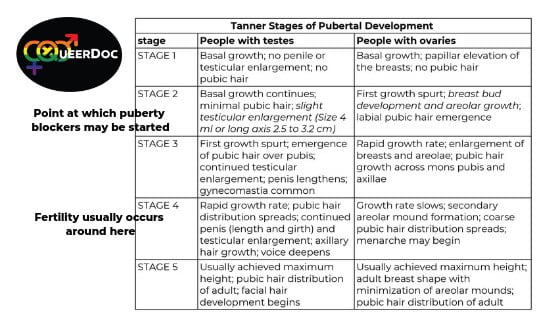Puberty is a gradual process of changes to a person’s body that takes several years. In young humans, puberty often starts during the tween and younger teen years. We use “Tanner Stages” to estimate how far a person has proceeded through puberty. We do sometimes use lab work and x-rays to help give us more information about a person’s stage in puberty, but the standard for assessing puberty progress remains the physical exam. The presence or absence of specific bodily changes as described by the Tanner Scale helps us determine where a person is in puberty. Note: we’ll use some anatomical language in this article.
What Are The Stages of the Tanner Scale?
The Tanner Scale was developed in the 1960s. During endogenous puberty, the body starts making more sex steroid hormones, and starts making more of specific hormones based on their chromosomes, gonads (ovaries or testicles,) body chemistry, and gland function. Endogenous means “from within a system” so it refers to hormones created by the body. Exogenous puberty is changes caused by hormones added to the body. You may notice people referring to “first puberty” and “second puberty.” The Tanner Scale uses descriptions of how the body is changing to determine which stage of puberty a youth is in.
Tanner Stage I is before puberty starts.
Stage II is early puberty. Puberty blockers are not prescribed before Tanner Stage 2.
Stage V is considered the end of puberty. Most individuals stop growing and reach their adult height during Tanner V.
Tanner Stages III and IV are mid-points.
What Body Changes Are Described In Each Tanner Stage?
Note: Puberty is different for every body!
For People with Testicles
Tanner Stage I is pre-puberty. The testicles and penis are small, and no pubic hair is present.
In Stage II, testicles start to get bigger, and their volume increases up to 6 ml, which is about the same space as a teaspoon of water. The scrotum gets bigger, and its skin thins and gets redder. Any pubic hair will be ,minimal and lightly colored.
In Stage III, the testicles continue to get bigger and volume increases to 12 ml, or about 2.5 teaspoons of space. The scrotum also continues to get larger, the penis lengthens, and pubic hair gets darker and curlier and starts to grow further out from the base of the penis and the scrotum.
In Stage IV, these changes continue. The scrotum continues to get larger and the skin darkens, while testicle volume increases up to 20 ml (4 teaspoons, or 1 tablespoon + 1 teaspoon.) The penis continues to get longer and starts to get thicker. Pubic hair looks like adult hair, and spreads further, but is not yet on the inner thighs.
Tanner Stage V is determined by testicular volume over 20 ml, with pubic hair appearing on the inner thighs.
For People with Ovaries
Tanner Stage I is pre-puberty. The areolas and area around them on the chest are not raised. No pubic hair is present.
Stage II is when breast buds form. The areola begins to get larger, and a small amount of glandular tissue may develop underneath the areola. Long, light pubic hair begins to grow on the labia majora.
In Stage III, breast tissue grows. The height of the areola will rise and the size of the mound underneath the areola will increase and start to spread out. Pubic hair becomes coarser and curlier and starts to spread.
In Tanner Stage IV, the breasts continue to grow in height and volume. The areola and nipple base will form a second mound on top of the breast base (may be “puffy.”) Pubic hair looks like adult hair, and spreads further, but is not yet on the inner thighs.
At Tanner Stage V, the areola mound may decrease, while the nipple extends. Pubic hair appears on the inner thighs.
For People with a Uterus
Menarche, or first menstruation/first period generally happens about two years after puberty starts, but this is highly variable.
Estimating Puberty in Telemedicine
We’ll never ask a youth to disrobe in an appointment. We gauge Tanner Stages by asking questions about the size and appearance of the body. We also encourage youth to practice saying no when we ask about body measurements, as bodily autonomy and consent drive everything we do.
Our Tanner Stages Quick Reference Card:

Other resources:
For younger children before puberty: Amaze.
For all kinds of body, sex, and relationship questions: Scarleteen.
For focused learning for trans and nonbinary teens about their bodies, sex, and relationships:
Transfamilies offers a six-week course on bodies, dating and sex, taught by a trans educator. This is an online course that is offered each Spring and Fall. Cost is $175, with sliding scale available. (The Fall 2023 series is currently in session.) Watch their blog, social media, or sign up for their newsletter for upcoming class information.







